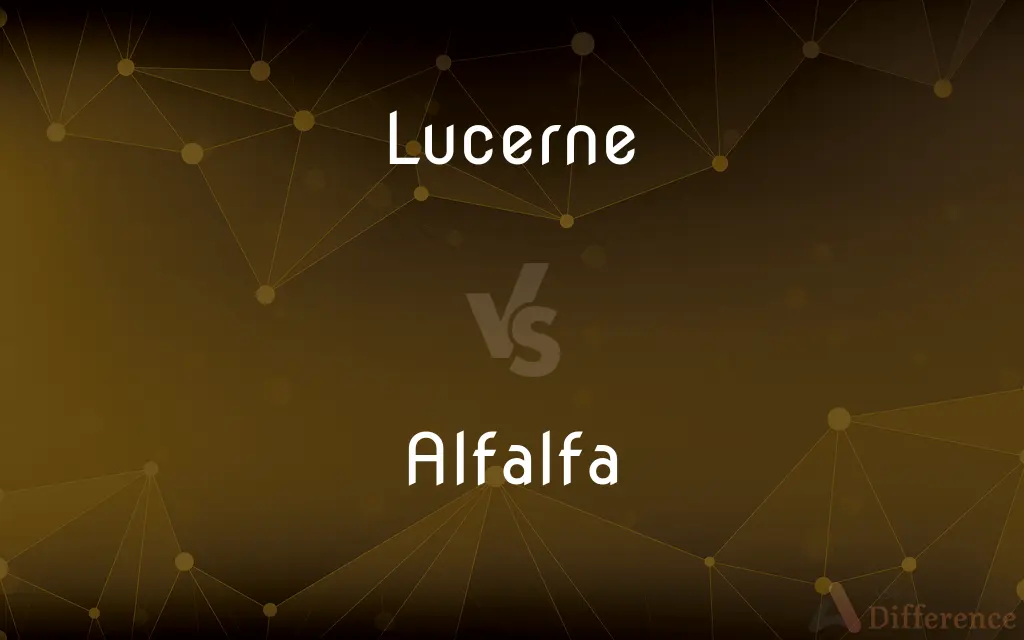Lucerne vs. Alfalfa — What's the Difference?
Edited by Tayyaba Rehman — By Maham Liaqat — Updated on March 25, 2024
Lucerne and Alfalfa refer to the same plant, Medicago sativa, a nutrient-rich forage crop, but the term "Lucerne" is primarily used in the UK and Commonwealth countries, while "Alfalfa" is used in the US.

Difference Between Lucerne and Alfalfa
Table of Contents
ADVERTISEMENT
Key Differences
Lucerne, known in many parts of the world, particularly in the UK and Commonwealth countries such as Australia and New Zealand, is a perennial flowering plant in the legume family. It is highly valued for its high nutrient content, making it an excellent feed for livestock. Alfalfa, on the other hand, is the name used in the United States for the same plant. The distinction between the terms "Lucerne" and "Alfalfa" primarily lies in regional language differences rather than any botanical or agricultural difference.
Both Lucerne and Alfalfa are known for their deep root systems, which allow them to thrive in varied climates and soil types, making them widely cultivated across the globe. These deep roots also contribute to the plant's resilience and its ability to improve soil health by fixing nitrogen, reducing the need for synthetic fertilizers in crop rotations.
In terms of usage, both Lucerne and Alfalfa are primarily grown as forage for livestock due to their high protein content and essential vitamins and minerals. They can be harvested as hay, silage, or used for grazing. The versatility of this plant extends beyond animal feed; it's also used in crop rotations to improve soil structure and fertility.
The nutritional content of Lucerne/Alfalfa is virtually identical since they are the same plant. Both are rich in vitamins (such as Vitamin K, Vitamin C, and beta-carotene), minerals (including calcium, potassium, iron, and zinc), and are high in protein content, which is beneficial for the diet of ruminants and other livestock.
Cultivation practices for Lucerne and Alfalfa are similar, emphasizing the importance of well-drained soils and the potential for multiple cuttings per growing season under the right environmental conditions. Farmers worldwide may choose the term more familiar in their region, but agronomically, the practices and considerations for growing Lucerne and Alfalfa do not differ.
ADVERTISEMENT
Comparison Chart
Regional Usage
Preferred in the UK and Commonwealth countries.
Commonly used in the United States.
Botanical Name
Medicago sativa
Medicago sativa
Cultivation
Grown for livestock feed, soil improvement, and crop rotation.
Same as Lucerne.
Nutritional Value
High in protein, vitamins, and minerals.
Identical to Lucerne as it is the same plant.
Soil Benefits
Improves soil health by fixing nitrogen.
Same soil benefits due to nitrogen fixation.
Compare with Definitions
Lucerne
Rich in protein and essential nutrients.
Lucerne hay is valued for its high nutritional content, especially for racehorses.
Alfalfa
Adapted to a wide range of climates, from temperate to arid.
Alfalfa's ability to thrive in different environments makes it a versatile crop for American farmers.
Lucerne
A perennial flowering plant in the legume family, used as forage.
Lucerne fields are a common sight in rural England, providing essential feed for dairy cows.
Alfalfa
Enhances soil structure and fertility through nitrogen fixation.
Farmers use Alfalfa in rotations to naturally enrich agricultural lands.
Lucerne
Requires well-drained soils; can withstand arid conditions.
Lucerne's deep root system allows it to access water from deep within the soil, making it drought-resistant.
Alfalfa
The same plant as Lucerne, used extensively for animal feed.
In the US, Alfalfa hay is a staple in the diet of dairy and beef cattle.
Lucerne
Used in crop rotations for its nitrogen-fixing ability.
Including Lucerne in crop rotations can significantly reduce the need for chemical fertilizers.
Alfalfa
Provides livestock with a high-quality source of protein.
Alfalfa pellets are a compact, nutritious feed option for small-scale livestock operations.
Lucerne
Known as Lucerne in the UK and Commonwealth.
Australian farmers often rotate their crops with Lucerne to enhance soil fertility.
Alfalfa
Preferred term in the United States.
Alfalfa cultivation covers millions of acres across the US, especially in the Midwest and West.
Lucerne
Lucerne ( loo-SURN, French: [lysɛʁn] (listen)) or Luzern (Swiss Standard German: [luˈtsɛrn] (listen)) is a city in central Switzerland, in the German-speaking portion of the country. Lucerne is the capital of the canton of Lucerne and part of the district of the same name.
Alfalfa
Alfalfa () (Medicago sativa), also called lucerne, is a perennial flowering plant in the legume family Fabaceae. It is cultivated as an important forage crop in many countries around the world.
Lucerne
Alfalfa.
Alfalfa
A southwest Asian perennial herb (Medicago sativa) in the pea family, having compound leaves with three leaflets and clusters of usually blue-violet flowers. It is widely cultivated as a pasture and hay crop.
Lucerne
(British) Alfalfa.
Alfalfa
(uncountable) A plant, principally of Medicago sativa, grown as a pasture crop.
Lucerne
See Lucern, the plant.
Alfalfa
(countable) A type or breed of this plant.
Lucerne
Important European leguminous forage plant with trifoliate leaves and blue-violet flowers grown widely as a pasture and hay crop
Alfalfa
The lucern (Medicago sativa), a leguminous plant having bluish purple cloverlike flowers, and cultivated for fodder; - so called in California, Texas, etc.
Alfalfa
Important European leguminous forage plant with trifoliate leaves and blue-violet flowers grown widely as a pasture and hay crop
Alfalfa
Leguminous plant grown for hay or forage
Common Curiosities
How does Lucerne/Alfalfa benefit the soil?
Its deep rooting system helps with nitrogen fixation, improving soil fertility and structure, making it beneficial in crop rotations.
What are the main uses of Lucerne/Alfalfa?
The plant is primarily grown as forage for livestock, but it's also used in crop rotations to improve soil health.
Why is the plant called Lucerne in some places and Alfalfa in others?
The naming difference is primarily due to historical and regional language variations, with "Lucerne" used in the UK and Commonwealth countries, and "Alfalfa" in the US.
Can Lucerne and Alfalfa be used interchangeably in farming?
Yes, since they are the same plant, farming practices and uses are interchangeable, with the choice of term depending on regional preference.
Is there a difference between Lucerne and Alfalfa?
No, Lucerne and Alfalfa are two names for the same plant, Medicago sativa, with the difference being regional terminology.
Can Lucerne/Alfalfa cultivation impact water usage?
Yes, its deep roots can access groundwater, making it more drought-resistant than some crops, but also potentially impacting water resources in arid regions.
How many times a year can Lucerne/Alfalfa be harvested?
Depending on the climate and growing conditions, it can be harvested multiple times a year, offering a reliable source of forage.
Is there a difference in the nutritional content of Lucerne and Alfalfa?
No, since they are the same plant, the nutritional content is identical, providing a rich source of protein and essential nutrients for livestock.
Are there any specific growing conditions preferred by Alfalfa/Lucerne?
It prefers well-drained soils and can tolerate a wide range of climatic conditions, from temperate to arid.
Is Alfalfa/Lucerne considered a good source of nutrition for all types of livestock?
Yes, it's high in protein, vitamins, and minerals, making it an excellent feed for ruminants, poultry, and even horses.
Share Your Discovery

Previous Comparison
Save vs. Safe
Next Comparison
Polarity vs. PolarizationAuthor Spotlight
Written by
Maham LiaqatEdited by
Tayyaba RehmanTayyaba Rehman is a distinguished writer, currently serving as a primary contributor to askdifference.com. As a researcher in semantics and etymology, Tayyaba's passion for the complexity of languages and their distinctions has found a perfect home on the platform. Tayyaba delves into the intricacies of language, distinguishing between commonly confused words and phrases, thereby providing clarity for readers worldwide.














































